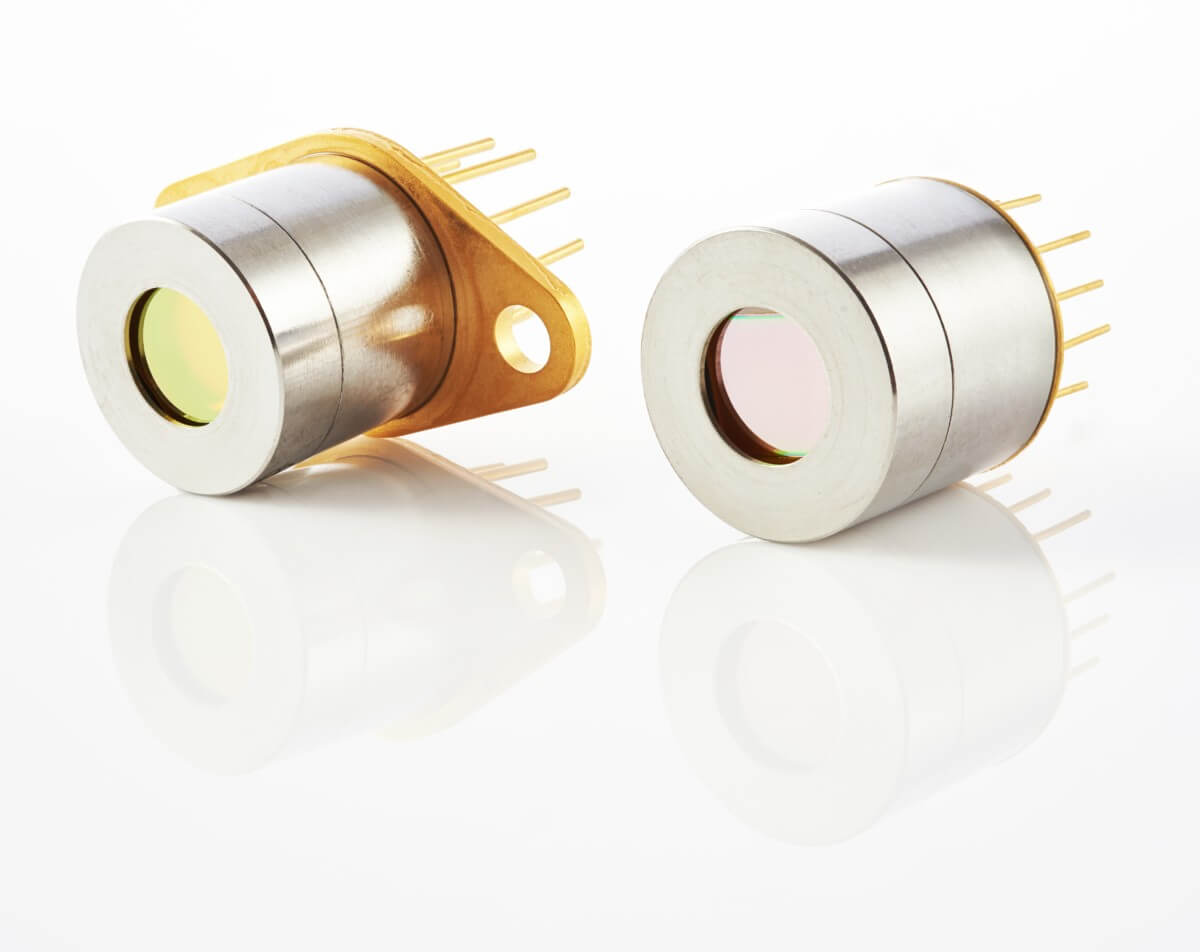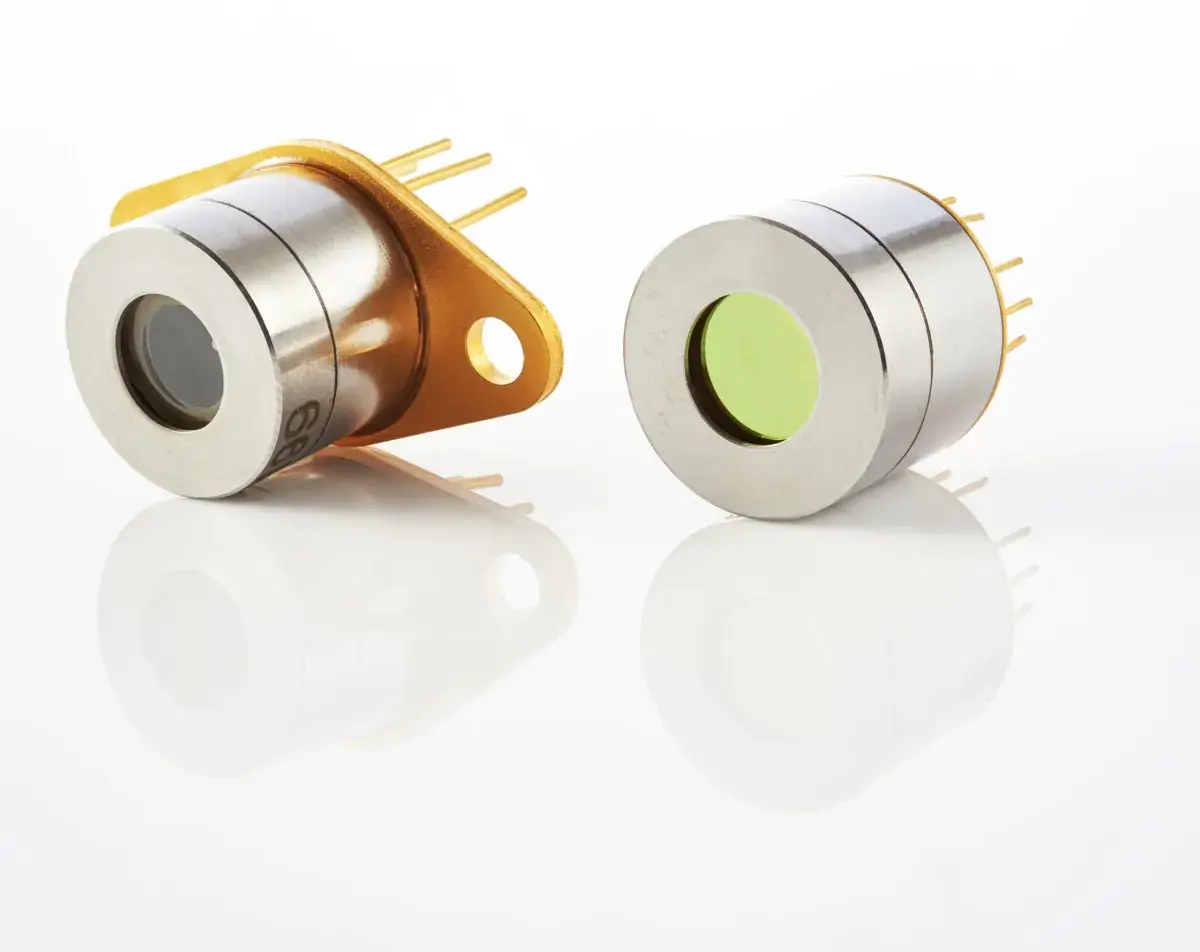HgCdTe Photovoltaic IR Detectors
Photovoltaic detectors (photodiodes) are semiconductor structures with one (PV) or multiple (PVM) , homo- or heterojunctions. Absorbed photons produce charge carriers that are collected at the contacts, resulting in external photocurrent. Photodiodes have complex current voltage characteristics.
The devices can operate either at flicker-free zero bias or with reverse voltage. Reverse bias voltage is frequently applied to increase responsivity, differential resistance, reduce the shot noise, improve high frequency performance and increase the dynamic range.
HgCdTe Photovoltaic IR Detectors - Selected Products
Filter results
Image
Name
Cooling
Optical immersion
Optical area
Ao, mm×mm
Cut-on wavelength (10%)
λcut-on(10%), μm
Peak wavelength
λpeak, μm
Cut-off wavelength (10%
λcut-on(10%), μm
Detectivity
D*(λpeak, 20kHz), cm·Hz1/2/W
Current responsivity
Ri(λpeak), A/W
Time constant
τ, ns
Package
Window
Datasheet
Cooling
no
Immersion
yes
Optical area
1×1
Cut-on wavelength cut-on
2.3
Peak wavelength
3.5
Cut-off wavelength cut-off
4.4
Detectivity
6.0×10\(^{10}\)
Responsivity
1.8
Time constant
150
Package
TO39
Window
no
Cooling
no
Immersion
yes
Optical area
1×1
Cut-on wavelength cut-on
2.0
Peak wavelength
4.4
Cut-off wavelength cut-off
5.4
Detectivity
2.5×10\(^{10}\)
Responsivity
2.0
Time constant
120
Package
TO39
Window
no
Cooling
2TE
Immersion
yes
Optical area
1×1
Cut-on wavelength cut-on
2.6
Peak wavelength
5.2
Cut-off wavelength cut-off
7.0
Detectivity
8.0×10\(^{10}\)
Responsivity
2.5
Time constant
50
Package
TO8
Window
wZnSeAR
Cooling
no
Immersion
no
Optical area
1×1
Cut-on wavelength cut-on
2.0
Peak wavelength
8.5
Cut-off wavelength cut-off
12.0
Detectivity
2.0×10\(^{7}\)
Responsivity
0.004
Time constant
1.5
Package
TO39
Window
no
HgCdTe Photovoltaic IR Detectors
Filter results
Image
Name
Cooling
Optical immersion
Cut-on wavelength (10%)
λcut-on(10%), μm
Peak wavelength
λpeak, μm
Cut-off wavelength (10%)
λcut-off(10%), μm
Detectivity
D*(λpeak, 20kHz), cm·Hz1/2/W
Current responsivity
Ri(λpeak), A/W
Time constant
τ, ns
Package
Window
Datasheet
Cooling
no
Immersion
yes
Cut-on wavelength cut-on
2.2
Peak wavelength
2.7
Cut-off wavelength cut-off
3.15
Detectivity
2.0×10\(^{11}\)
Responsivity
1.4
Time constant
150
Package
TO39
Window
no
Cooling
2TE
Immersion
yes
Cut-on wavelength cut-on
2.2
Peak wavelength
2.8
Cut-off wavelength cut-off
3.25
Detectivity
1.5×10\(^{12}\)
Responsivity
1.4
Time constant
280
Package
TO8, TO66
Window
wAl\(_{2}\)O\(_{3}\)
Cooling
4TE
Immersion
yes
Cut-on wavelength cut-on
2.2
Peak wavelength
2.8
Cut-off wavelength cut-off
3.35
Detectivity
2.0×10\(^{12}\)
Responsivity
1.4
Time constant
280
Package
TO8, TO66
Window
wAl\(_{2}\)O\(_{3}\)
Cooling
no
Immersion
no
Cut-on wavelength cut-on
2.3
Peak wavelength
3.5
Cut-off wavelength cut-off
4.3
Detectivity
6.0×10\(^{9}\)
Responsivity
1.8
Time constant
150
Package
TO39
Window
no
Cooling
2TE
Immersion
no
Cut-on wavelength cut-on
2.3
Peak wavelength
3.5
Cut-off wavelength cut-off
4.4
Detectivity
4.0×10\(^{10}\)
Responsivity
1.8
Time constant
100
Package
TO8, TO66
Window
wAl\(_{2}\)O\(_{3}\)
Cooling
no
Immersion
yes
Cut-on wavelength cut-on
2.3
Peak wavelength
3.5
Cut-off wavelength cut-off
4.4
Detectivity
6.0×10\(^{10}\)
Responsivity
1.8
Time constant
150
Package
TO39
Window
no
Cooling
2TE
Immersion
yes
Cut-on wavelength cut-on
2.3
Peak wavelength
3.5
Cut-off wavelength cut-off
4.4
Detectivity
5.0×10\(^{11}\)
Responsivity
1.8
Time constant
100
Package
TO8, TO66
Window
wAl\(_{2}\)O\(_{3}\)
Cooling
3TE
Immersion
yes
Cut-on wavelength cut-on
2.3
Peak wavelength
3.6
Cut-off wavelength cut-off
4.4
Detectivity
5.5×10\(^{11}\)
Responsivity
1.8
Time constant
100
Package
TO8, TO66
Window
wAl\(_{2}\)O\(_{3}\)
Cooling
4TE
Immersion
yes
Cut-on wavelength cut-on
2.3
Peak wavelength
3.6
Cut-off wavelength cut-off
4.4
Detectivity
6.0×10\(^{11}\)
Responsivity
1.8
Time constant
100
Package
TO8, TO66
Window
wAl\(_{2}\)O\(_{3}\)
Cooling
no
Immersion
no
Cut-on wavelength cut-on
2.0
Peak wavelength
4.4
Cut-off wavelength cut-off
5.4
Detectivity
2.5×10\(^{9}\)
Responsivity
2.0
Time constant
120
Package
TO39
Window
no
Cooling
2TE
Immersion
no
Cut-on wavelength cut-on
2.3
Peak wavelength
4.4
Cut-off wavelength cut-off
5.6
Detectivity
1.7×10\(^{10}\)
Responsivity
2.1
Time constant
80
Package
TO8, TO66
Window
wAl\(_{2}\)O\(_{3}\)
Cooling
no
Immersion
yes
Cut-on wavelength cut-on
2.0
Peak wavelength
4.4
Cut-off wavelength cut-off
5.4
Detectivity
2.5×10\(^{10}\)
Responsivity
2.0
Time constant
120
Package
TO39
Window
no
Cooling
2TE
Immersion
yes
Cut-on wavelength cut-on
2.7
Peak wavelength
4.4
Cut-off wavelength cut-off
5.6
Detectivity
1.8×10\(^{11}\)
Responsivity
2.1
Time constant
80
Package
TO8, TO66
Window
wAl\(_{2}\)O\(_{3}\)
Cooling
3TE
Immersion
yes
Cut-on wavelength cut-on
2.7
Peak wavelength
4.4
Cut-off wavelength cut-off
5.5
Detectivity
2.3×10\(^{11}\)
Responsivity
2.1
Time constant
80
Package
TO8, TO66
Window
wAl\(_{2}\)O\(_{3}\)
Cooling
4TE
Immersion
yes
Cut-on wavelength cut-on
2.7
Peak wavelength
4.4
Cut-off wavelength cut-off
5.2
Detectivity
2.5×10\(^{11}\)
Responsivity
2.1
Time constant
80
Package
TO8, TO66
Window
wAl\(_{2}\)O\(_{3}\)
Cooling
2TE
Immersion
no
Cut-on wavelength cut-on
2.6
Peak wavelength
5.2
Cut-off wavelength cut-off
6.8
Detectivity
8.0×10\(^{9}\)
Responsivity
2.5
Time constant
50
Package
TO8, TO66
Window
wZnSeAR
Cooling
4TE
Immersion
no
Cut-on wavelength cut-on
2.6
Peak wavelength
5.2
Cut-off wavelength cut-off
6.8
Detectivity
1.2×10\(^{10}\)
Responsivity
2.5
Time constant
50
Package
TO8, TO66
Window
wZnSeAR
Cooling
no
Immersion
yes
Cut-on wavelength cut-on
2.5
Peak wavelength
5.1
Cut-off wavelength cut-off
6.5
Detectivity
8.0×10\(^{9}\)
Responsivity
2.0
Time constant
80
Package
TO39
Window
no
Cooling
2TE
Immersion
yes
Cut-on wavelength cut-on
2.6
Peak wavelength
5.2
Cut-off wavelength cut-off
7.0
Detectivity
8.0×10\(^{10}\)
Responsivity
2.5
Time constant
50
Package
TO8, TO66
Window
wZnSeAR
Cooling
4TE
Immersion
yes
Cut-on wavelength cut-on
2.6
Peak wavelength
5.4
Cut-off wavelength cut-off
7.0
Detectivity
1.2×10\(^{11}\)
Responsivity
2.5
Time constant
50
Package
TO8, TO66
Window
wZnSeAR
Cooling
4TE
Immersion
no
Cut-on wavelength cut-on
3.0
Peak wavelength
6.5
Cut-off wavelength cut-off
10.6
Detectivity
5.0×10\(^{8}\)
Responsivity
1.9
Time constant
45
Package
TO8, TO66
Window
wZnSeAR
Cooling
2TE
Immersion
yes
Cut-on wavelength cut-on
3.0
Peak wavelength
6.0
Cut-off wavelength cut-off
10.6
Detectivity
4.0×10\(^{9}\)
Responsivity
1.6
Time constant
45
Package
TO8, TO66
Window
wZnSeAR
Cooling
4TE
Immersion
yes
Cut-on wavelength cut-on
3.0
Peak wavelength
6.5
Cut-off wavelength cut-off
10.0
Detectivity
5.0×10\(^{9}\)
Responsivity
3.0
Time constant
45
Package
TO8, TO66
Window
wZnSeAR
Cooling
2TE
Immersion
no
Cut-on wavelength cut-on
2.0
Peak wavelength
7.0
Cut-off wavelength cut-off
10.0
Detectivity
4.0×10\(^{8}\)
Responsivity
0.02
Time constant
4
Package
TO8, TO66
Window
wZnSeAR
Cooling
2TE
Immersion
no
Cut-on wavelength cut-on
2.0
Peak wavelength
7.0
Cut-off wavelength cut-off
10.0
Detectivity
4.0×10\(^{8}\)
Responsivity
0.01
Time constant
4
Package
TO8, TO66
Window
wZnSeAR
Cooling
2TE
Immersion
no
Cut-on wavelength cut-on
2.0
Peak wavelength
7.0
Cut-off wavelength cut-off
10.0
Detectivity
4.0×10\(^{8}\)
Responsivity
0.007
Time constant
4
Package
TO8, TO66
Window
wZnSeAR
Cooling
4TE
Immersion
yes
Cut-on wavelength cut-on
2.0
Peak wavelength
7.0
Cut-off wavelength cut-off
9.8
Detectivity
8.0×10\(^{9}\)
Responsivity
0.4
Time constant
4
Package
TO8, TO66
Window
wZnSeAR
Cooling
3TE
Immersion
yes
Cut-on wavelength cut-on
3.0
Peak wavelength
8.0
Cut-off wavelength cut-off
12.0
Detectivity
2.3×10\(^{11}\)
Responsivity
0.9
Time constant
10
Package
TO8, TO66
Window
wZnSeAR
Cooling
4TE
Immersion
yes
Cut-on wavelength cut-on
3.0
Peak wavelength
8.0
Cut-off wavelength cut-off
12.0
Detectivity
4.0×10\(^{9}\)
Responsivity
1.0
Time constant
25
Package
TO8, TO66
Window
wZnSeAR
Cooling
4TE
Immersion
yes
Cut-on wavelength cut-on
3.0
Peak wavelength
8.0
Cut-off wavelength cut-off
12.0
Detectivity
4.0×10\(^{9}\)
Responsivity
1.0
Time constant
25
Package
TO8, TO66
Window
wZnSeAR
Cooling
no
Immersion
no
Cut-on wavelength cut-on
2.0
Peak wavelength
8.5
Cut-off wavelength cut-off
12.0
Detectivity
2.0×10\(^{7}\)
Responsivity
0.004
Time constant
1.5
Package
TO39
Window
no
Cooling
no
Immersion
no
Cut-on wavelength cut-on
2.0
Peak wavelength
8.5
Cut-off wavelength cut-off
12.0
Detectivity
2.0×10\(^{7}\)
Responsivity
0.002
Time constant
1.5
Package
TO39
Window
no
Cooling
2TE
Immersion
no
Cut-on wavelength cut-on
2.0
Peak wavelength
9.0
Cut-off wavelength cut-off
13.0
Detectivity
1.5×10\(^{8}\)
Responsivity
0.015
Time constant
4
Package
TO8, TO66
Window
wZnSeAR
Cooling
2TE
Immersion
no
Cut-on wavelength cut-on
2.0
Peak wavelength
9.0
Cut-off wavelength cut-off
13.0
Detectivity
1.5×10\(^{8}\)
Responsivity
0.007
Time constant
4
Package
TO8, TO66
Window
wZnSeAR
Cooling
2TE
Immersion
no
Cut-on wavelength cut-on
2.0
Peak wavelength
9.0
Cut-off wavelength cut-off
13.0
Detectivity
1.5×10\(^{8}\)
Responsivity
0.0045
Time constant
4
Package
TO8, TO66
Window
wZnSeAR
Cooling
no
Immersion
yes
Cut-on wavelength cut-on
2.0
Peak wavelength
8.5
Cut-off wavelength cut-off
12.0
Detectivity
2.0×10\(^{8}\)
Responsivity
0.02
Time constant
1.5
Package
TO39
Window
no
Cooling
2TE
Immersion
yes
Cut-on wavelength cut-on
2.0
Peak wavelength
8.0
Cut-off wavelength cut-off
13.0
Detectivity
2.0×10\(^{9}\)
Responsivity
0.2
Time constant
3
Package
TO8, TO66
Window
wZnSeAR
Cooling
4TE
Immersion
yes
Cut-on wavelength cut-on
2.0
Peak wavelength
9.0
Cut-off wavelength cut-off
12.0
Detectivity
3.0×10\(^{9}\)
Responsivity
0.36
Time constant
3
Package
TO8, TO66
Window
wZnSeAR
HgCdTe Photoelectromagnetic IR Detectors
Filter results
Image
Name
Cooling
Optical immersion
Cut-on wavelength (10%)
λcut-on(10%), μm
Peak wavelength
λpeak, μm
Cut-off wavelength (10%)
λcut-off(10%), μm
Detectivity
D*(λpeak, 20kHz), cm·Hz1/2/W
Current responsivity
Ri(λpeak), A/W
Time constant
τ, ns
Package
Window
Datasheet
Cooling
no
Immersion
no
Cut-on wavelength cut-on
2.0
Peak wavelength
8.5
Cut-off wavelength cut-off
12.0
Detectivity
2.0×10\(^{7}\)
Responsivity
0.004
Time constant
1.2
Package
PEM-SMA
Window
wZnSeAR
FAQ
In this section, you can read about the most frequently asked questions and answers about VIGO Photonics products.
What is an MCT detector, and how does it work?
MCT detector is an infrared detector with tunable bandgap in which the detection structure is made of mercury, cadmium and telluride, also known as the HgCdTe detector. It is a semiconductor electro-optical device that converts infrared radiation into an electrical signal.
What are the advantages of using HgCdTe detectors in various applications?
HgCdTe detectors show superior detectivity, in some cases approaching theoretical limits of detection. Additionally, very short time constants allow measurements with very high temporal resolution. Combination of those two features helps achieve best possible results in a variety of applications.
How does an MCT photodiode differ from a regular photodiode?
MCT photodiodes are crafted to work best for a specific wavelength, ranging between 1 and 16 um, often at background-limited detectivity - meaning that they are the best solution for MWIR and LWIR detection.
What types of applications are MCT detectors and photovoltaic sensors suitable for?
The high performance of our detectors makes them suitable for a wide range of applications. The key applications our detectors are primarily utilized for include gas sensing and analysis, railway transport safety, environmental monitoring, as well as in security and defense applications like heat seeking.
Can you explain the technology behind VIGO Photonics' advanced MCT detectors and photovoltaic sensors?
At VIGO Photonics, the optical immersion is created directly with the use of the substrate on which the active layer of the detector is placed. This means the lens is an integral part of the device – no adhesives or other joints that could generate losses are used for its fabrication. A monolithic lens does not need to be aligned by the customer in any way, and it reaches its maximum efficiency already during the manufacturing process.
For more information please visit our website: https://vigophotonics.com/articles/immersion-lenses-technology/
What is the sensitivity range of VIGO Photonics' MCT detectors and photovoltaic sensors?
Our detectors are optimized for MWIR (3-8μm) and LWIR (8-16μm) spectral ranges, however the specific wavelength range that detectors can cover depends on the type of detector. For more precise and up-to-date information, you should refer to the product specifications you can find on our website.
Are VIGO Photonics' detectors and sensors customizable for specific applications?
While we offer a diverse selection to cover most common applications, we understand that some applications may require a more specialized solution. If you have a very specific application that requires unique specifications not found in our current catalog, we can manufacture custom products matching your requirements. Please feel free to reach out to our sales team to initiate a discussion about your specific requirements.
How reliable and durable are MCT detectors and photovoltaic sensors in different environmental conditions?
Our devices can operate in the 10% to 80% humidity, in the –20°C to +30°C ambient temperature range. Operation at >30°C ambient may reduce performance for standard Peltier coolers. Ask for devices that can operate in the +30°C to +80°C ambient temperature range.
What support and technical assistance does VIGO Photonics provide for integrating MCT detectors and photovoltaic sensors into new or existing systems?
Our application engineers are ready to provide a beginning-to-end support in integration of our products, starting from application advice and sample delivery, to help in analysis of your results, tailored electronics to cooperate with the detector and industrialization of the final product.
Load more
















